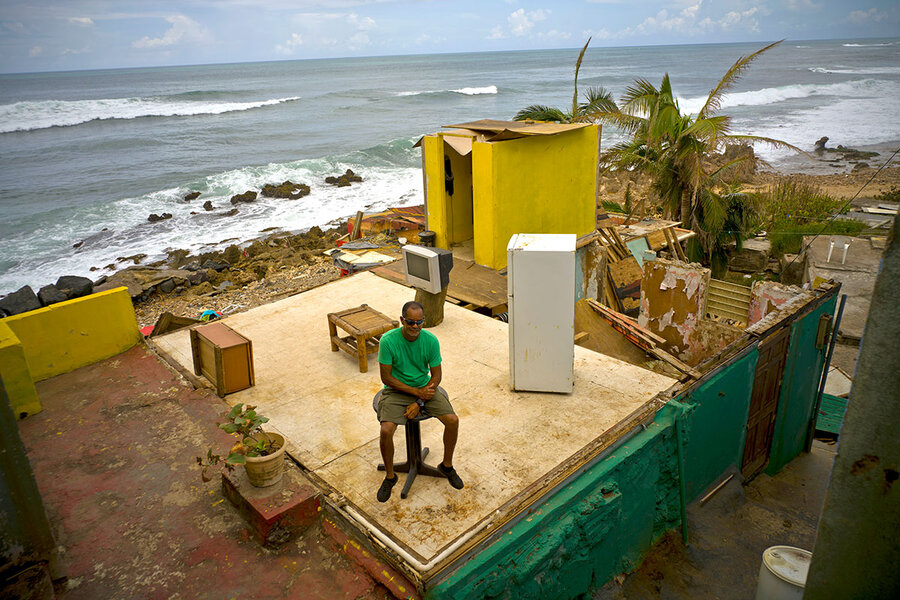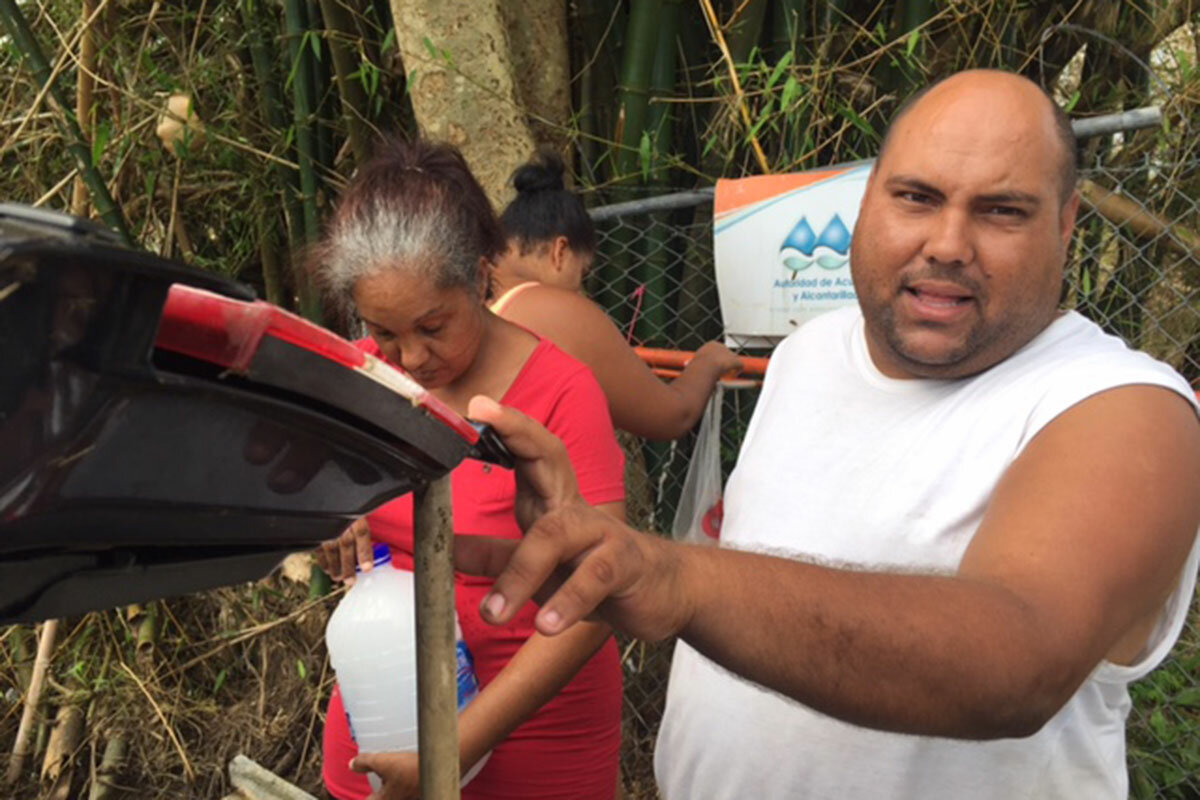San Juan residents pitch in with cleanup, lifting their own spirits
Loading...
| San Juan, Puerto Rico
When Paula Paulino saw the destruction that hurricane Maria left in its wake at the once-lush Rio Piedras main campus of the University of Puerto Rico, she felt empty and lost.
But then the art history major picked up a rake. She joined an army of students, parents, alumni, and faculty helping to clear fallen trees and gather the debris of the 100-year storm that walloped the university as it did the entire island.
And suddenly she found herself feeling hopeful, that maybe everything wasn’t lost after all.
“This college is really the only place I can call home, so it’s important to me that it is repaired and starts working again,” says Ms. Paulino, sporting a t-shirt reading “mi casa, mi iupi” – roughly “my house, my university.”
“I think if so many students and others came out to help,” she adds, “it’s because we want to feel like we’re part of putting back together something we love.”
There can be no varnishing over of Puerto Rico’s broken state.
More than two weeks after the unprecedented one-two punch of hurricanes Irma and Maria, almost 90 percent of Puerto Ricans remain without power. Just over half the population now has running water. Thousands of homes were destroyed, while thousands more lost roofs and windows.
Most schools will remain closed until at least Oct. 23, as many schools continue to serve as shelters for those left homeless. And an already anemic economy will likely take a $40 billion gut punch from Maria, economists estimate, as thousands of businesses from mom-and-pops to large enterprises remain closed indefinitely.
Even many of the disaster-hardened recovery professionals operating out the FEMA command post at San Juan’s convention center say they’ve never seen anything quite like Puerto Rico, post-Maria.
“This is a unique situation, one I can tell you I’ve never experienced,” says a member of the Arizona National Guard’s famed Copperheads, who requested anonymity since he was not authorized to speak for his unit.
“You had two hurricanes one right after the other, and almost a third until it veered off, and all that made for very complicated logistics as units got in place but then had to shelter to be able to respond when it was all over,” says the airman, one of the 11,500 personnel the Department of Defense and FEMA have assembled here. “I don’t think people understand that this is an effort that’s been going on for a month.”
New growth
Or as Puerto Rico’s governor, Ricardo Rosselló, said Thursday when asked for the millionth time if the island wasn’t indeed “paralyzed” and if the recovery effort hasn’t fallen short, “Do we need to do more? Yes we do. And will we continue to improve our response and do more, yes we will.”
He then added, “Let’s not forget, we had two category 4 and 5 hurricanes within a span of two weeks.”
Surely none of the 3.4 million American citizens of this United States territory is at risk of forgetting any time soon.
But at the same time, Puerto Rican society is starting to mirror in some degree the island’s jarring post-Maria natural landscape, where the ghostly gray-brown of wind-slashed and denuded tropical trees is already being overtaken by the iridescent green of emphatic new growth.
In San Juan, more lights are back on every day, as it is here, in the capital, that the 10.7 percent of island residents with power are clustered. Restaurants still shuttered a week ago are bustling again, serving up platters of roasted chicken, yucca, plantain, and dirty rice.
Community spirit
The 2,500 volunteers who assembled to clean up the University of Puerto Rico were just one example of the community spirit that some here say they’ve seen grow since calamity hit.
“I know there are people like President Trump who say the people here just want everything to be done for them, but I feel like it’s the citizens, and a lot of them young people, who are getting out and getting the recovery done,” says Natalie Sierra, a drama major working alongside Ms. Paulino. “We feel like Puerto Rico has given us a lot, and we want to give back.”
The island’s ports are now running at about 60 percent of capacity, with Mr. Rosselló pledging to reach 80 percent of capacity by the end of the month. More offloaded containers mean that more products like electrical generators can come to the rescue of an island that isn’t likely to see power fully restored until sometime next year.
And to the relief of almost everyone, lines for gasoline have shrunk, and more banks and ATMs are open in what has largely reverted to being a cash economy, as credit card terminals remain down.
Perhaps most of all, people are grateful for the relatively low mortality for such a monstrous calamity, a factor Mr. Trump highlighted when he visited the island Tuesday. On Friday Rosselló put the storm’s toll at 36.
Even in capital, signs of distress
Still, one doesn’t have to leave the capital to find sign of distress. This week the residents of San Juan’s Playita neighborhood made the news when they hung banners from adjacent expressway overpasses crying, “SOS, Playita needs food and water.”
But clearly conditions worsen the farther one goes from San Juan’s restored lights.
In the town of Naguabo, about 60 miles from the capital on the island’s eastern edge, a steady stream of residents stop to fill jugs and repurposed liter soda bottles at a stand pipe installed by the local water authority.
“We get a different story every day about why we still don’t have water in our neighborhood, but the latest one we heard is that they don’t have the diesel to run the generators to get the pumps going again,” says Vidar Arroyo, who is standing by as his wife and daughter fill one bottle after another at the pipe. “I guess they’re doing what they can,” he adds, “but it seems like it’s taking a long time for things to improve.”
The unemployed used car salesman says that he depends on food stamps, like many in his area, but he worries that none of the nearby markets are able to process the debit cards that the government issues to provide food assistance.
Depending on one another
In the absence of government services, from water to schools and food stamps, Mr. Arroyo says people are turning to and depending more on one another.
“There is a spirit of ‘We are in this together’; I know in our neighborhood everyone pitched in to cut down fallen trees and clear the roads,” he says. “And that’s been great, but there are things we can’t do – like put back the electric lines or make the water pumps work.”
Another type of spirit – the entrepreneurial variety – is on display down the road, where Richard Felix and his young son Richardy are busy selling large plastic containers to passers-by.
Mr. Felix has seen his work at a steel and plastics company reduced to 20 hours a week in the wake of Maria, so he decided to try making up for lost income by buying and then selling at a profit the containers sitting unsold at his place of employment.
“When things get rough like they are now, you have to find ways to get by,” he says.
Fear of rising emigration
Felix says that so far he’s making enough to hold on and see if what he considers to be a slow recovery pace starts to pick up steam. But Rosselló says he worries that Maria will turn what was already a rising emigration from the island to Florida and other states into a stampede.
“The problem of the exodus could accelerate as a result of this situation, and it could become a serious issue, not just for Puerto Rico but for the United States,” the governor says.
Indeed Puerto Rico’s population fell from almost 3.8 million in 2007 to 3.4 million last year, with some demographers projecting another 100,000 or more leaving this year – perhaps a third of those the result of Maria.
Back at the Naguabo water pipe, Amelia and Angel Gravlau say they know well the push and pull of their island’s relationship with the US – all five of their children now live in the States.
“After this hurricane they all said, ‘Now you really must come over here to live,’ but how can we,” says Amelia, filling a jug. “We have our home here.”







